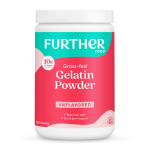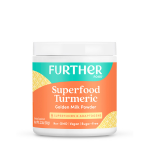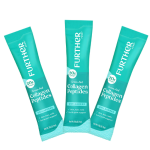Further Food has helped thousands of people cut out sugar and improve their overall health through its informative articles and healthy sugar free products such as Further Food Collagen. We understand how difficult it can be to cut out sugar, and figuring out the sugar detox do’s and don’ts, especially when it comes to what you can and cannot eat. As we all know, sugar is in so many foods and there are so many types of sugar! Here, we’ve compiled all your questions on how, why and what you should eat, and Registered Dietitian and Further Food Sugar Detox Expert, Mary Opfer answers them all. Learn about sugar, how it affects your body, and all the sugar detox do’s and don’ts when doing the challenge.
Why do we need to cut out sugar?
Scientifically speaking, sugar is a simple carbohydrate that the body converts to glucose and uses for energy. The problem arises when we eat too much sugar, whatever the source. Our bodies store this extra sugar as fat, leading to weight gain, obesity, and many chronic diseases including heart disease and diabetes. Additionally, sugar is highly addictive, so the more sugar we eat, the more sugar we want, leading to a vicious cycle that ends up in poor health.
Why do I crave sugar and sweet treats?
Most of us know that eating something sugary gives us a temporary high. The spike in energy we get from that donut or cookie quickly spirals downward, and we end up feeling a lot worse than before we ate the sugary treat. This is due to the drastic rise and fall in blood glucose levels after we eat anything with a lot of sugar. Unfortunately, sugar creates a false energy. Soon after eating sugar, we end up more fatigued, have a harder time concentrating and cranky (sound familiar?). This makes us want to eat more sugar to recreate that momentary high. But this is very short-term and not worth it!
Luckily, after we cut out the addictive sugary stuff, we can restore balance to our blood sugar levels and our mood. No more cravings!
Can I eat fruits and vegetables on a sugar detox? Don’t they have sugar?
As you cut out sugar, it is important to know that there is a huge difference between natural sugars and added sugars. The natural sugars in fruits and vegetables are fine in moderation. Fructose, the sugar naturally found in fruits and some vegetables, is considered a natural sugar, but it is metabolized differently by the body than added sugar.
In fact, fruits and vegetables provide lots of beneficial nutrients, including vitamins, minerals, phytonutrients and fiber, which can impact how your body breaks down the natural sugar in these foods. So when you eat an apple, which has natural sugar, the natural fiber in the apple helps to slow down your digestion of the sugar, and result in less of a blood sugar spike.
Moderation is important:
Note that some fruits and vegetables are higher in fructose than others. Fruits high in fructose include grapes, all dried fruits, jackfruit, kiwi and bananas. Vegetables high in fructose include tomatoes, corn, carrots, mushrooms, cucumber, beans and root vegetables. You may want to eat moderate amounts of these to limit your fructose intake. You can refer to the Further Food YES/NO infographic for more guidance on which fruits and vegetables to limit or avoid during a detox.
What is the glycemic index?
The glycemic index relates to the amount of sugar in certain foods and the effect it has on the rise of your blood sugar level. The higher the glycemic index, the higher it raises your blood sugar. Examples of vegetables with a high index are corn, peas, butternut squash, parsnips and carrots. However, most vegetables have a low index and can be eaten in large quantities. Fruits in general tend to have more sugar than vegetables. Some of the high-glycemic fruits include ripe bananas, pineapples and watermelon.
What about honey and maple syrup?
As a beekeeper, I love raw honey and use it in a variety of ways. Raw honey, unlike commercial honey you might purchase in the store, is unfiltered and unheated so the nutritional value and health benefits are intact. For this reason, we can consider raw honey a natural sugar. The benefits of raw honey include helping with pollen allergies, giving the body an antioxidant boost and helping the immune system run smoothly.
Raw or natural maple syrup is also unrefined and unprocessed, which means all of its nutritional value remains when we eat it. Raw maple syrup is a low-glycemic sweetener, compared to man-made sweeteners like high-fructose corn syrup. Maple syrup is high in antioxidants and phytochemicals and boosts magnesium, iron and zinc levels in the body.
Again, while honey and maple syrup have qualities that support health, they should still be consumed in moderation. Sugar of any type can be addicting and should be used sparingly.
Why are honey and maple syrup not allowed during the Further Food sugar detox?
The best way to do this is by cutting out all sweeteners and added sugars. For the 7 days of the sugar detox, we recommend that you only eat natural sugars found in fruits and vegetables. Once the detox is over, you can try adding in honey and maple syrup if you wish, but remember, these should be consumed in very limited quantities.
Are artificial sweeteners OK?
It might be tempting to feed your sugar craving with artificial sweeteners such as Equal, Splenda, etc. But my recommendation is skip the artificial stuff! Fake sugar can present a whole host of other health issues, and it may even cause the same metabolic disorders as real sugar! That’s because these artificial sweeteners cause a temporary rise in our insulin levels, leading to hormonal imbalances and inflammation. Plus artificial sweeteners can also cause skin disorders like rosacea and acne!
If you must sweeten your coffee, Further Food allows limited quantities of stevia during a sugar detox.
What are added sugars and why do I need to limit them?
Added sugars, such as table sugar and high-fructose corn syrup, can be found in processed and manufactured foods and are metabolized differently than natural sugars. They alter digestion and gut health and when consumed in high amounts contribute to chronic inflammation. Consuming large amounts of added sugars is also associated with diabetes, heart disease, cancer and weakened immune function.
Added sugars don’t provide any additional nutrients, this is why they are called “empty calories.”
Added sugars should be limited and removed entirely from your diet. Most of us understand that this means cutting out soft drinks and other sweetened drinks, candy and desserts. But the tricky part is that added sugars are often “hidden” and found in unlikely sources such as condiments or seemingly healthy options like granola. For example, ketchup, salad dressings, breads, energy drinks, power and protein bars and even granola contain added sugar. Processed breads are one of the big offenders of high-fructose corn syrup as an added sugar source. In fact, HFCS can be found in more than 40 percent of the processed products on the shelves in the stores today.
Learning to read food labels:
The best way to avoid added sugars is to eat mostly unprocessed foods-what comes from the ground and is found in nature. If you eat something that is packaged, read the ingredient panel on the label. Look for sugar, high fructose corn syrup and other “hidden sugars” including maltodextrin, corn syrup, cane juice, carob syrup, rice syrup, dextrose and evaporated corn sweetener. These foods should be removed completely during a detox, and hopefully permanently too.
How do I know how much added sugar is in food?
Sometimes it can be confusing figuring out just how much added sugar is in food. Divide the number of grams of sugar that are listed on the label by 4. For example, one of the top-selling yogurts with fruit in it has 18 grams of sugar. Divide 18 by 4 and you get 4.5. What does that mean? Eighteen grams of sugar on a label is the same as 4.5 teaspoons of sugar in that 6-ounce serving. Now that you now that, you just might not want to eat that yogurt after all! Or opt for no sugar added yogurt and top it yourself with some fresh fruit.
Want to read more?
Craving Sugar? Here’s 9 Hacks To Help You Break Your Sugar Addiction
Why Sugar is Bad For Your Skin Explained by Dermatologist Dr. Bowe

























